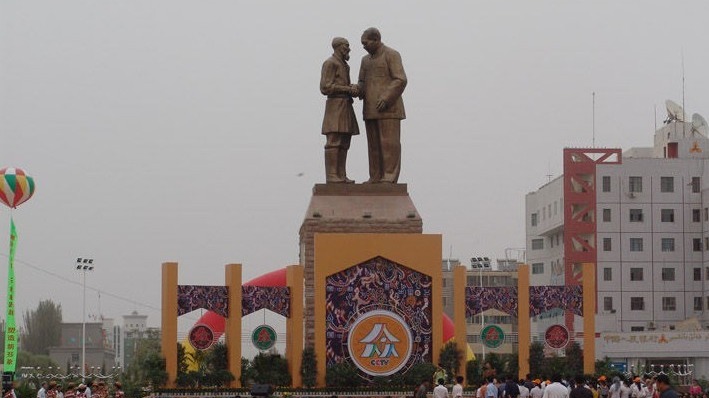“Cultural Exchange Activities of Presenting China to the World”---“The Most Beautiful China” Series Activities of Visiting Hotan, World Capital of Jade
Situated in Hotan Prefecture, the southwestern part of Xinjiang Uyghur Autonomous Region, Hotan City is in an oasis on the southern fringe in Taklamakan Desert. It has a long history, glorious civilization, full-bodied minority custom and unique tourism resources. Dominated southern part of ancient West Regions, Hotan is located in Kunlun Mountains to the south, Taklamakan Desert to the north, Tibet in the southeast, India and Pakistan in the southwest. Hotan was previously known in Chinese as Yutian in ancient times, it is an important station on the southern branch of the historical Silk Road and a must pass between the east and the west, well known for its jade, carpet and silk as a major commercial spot in the southern stretch of Silk Road as well as an important town in ancient West Regions. Over the past two thousand years, the Four Ancient Civilizations gathered here and created dazzling ancient culture, leaving tremendous cultural heritage and landscape to posterity. Its distinct natural scene, rich ethic customs, magnificent artificial landscape and rich characteristic tourism products have attracted numerous tourists at home and abroad, especially known with its jade, carpet and silk, gaining the reputation as “home of jade, silk, carpet, fruits and music”, till today, we can still experience its unique glamour from the songs and dances.
There are masses of heritage sites of Buddhism and cultural relics in Hotan. In the main, these are: Ancient City of Niya, Arxpili, Mallikurwatur, Karamound, Endere and Acis, Athar Ancient Castle as well as Ancient City of Yotkan, Rarak Pagoda and Cookmaramu Grotto. All these are world-renowned ancient sites, recording the footprints of Father Time, and acting as enchanting epics. Those unearthed ancient wood prints, debris of silk carpet, gold statues of Buddha, mummies, the most ancient coins as well as various clothing appliances in ancient burial complex, these all shine the charm of ancient civilization, proved to be the most reliable historical materials in the research of Western Region history. When tourists visit these historical relics, they can not help but marveling at their essence. In Hotan, you can see distinctive tourism resources, towering snow mountain, surpassing glacier, deep and serene grottoes, immemorial cliff painting, fantastic mountain basin, mysterious dessert and forest, the largest flow desert, magic Hongbai Mountain, vast grassland, beautiful lakes and marshes, idyllic scenery with forests, as well as king of walnuts, king of figs, king of grapes and king of sycamore trees.Of course, you will have a chance to visit Hotan River, the only river across Taklamakan Desert, explorers called it “River for Warrior”, its branch, the White Jade(Yurungkash) and Black Jade (Karakash) Rivers are famous for their separative production of suet jade and dark jade. Hotan jade has a history of at least 7,000 years, forming the major chapter of China’s jade culture. Kunlun Mountain is the only source of Hotan jade with 3 million tons of this rare resources to be tapped.
Hotan jade is a nephrite, commonly known as true jade. This kind of jade spreads over Kunlun Mountain, southern part of Tarim Basion, extending from Mountain Antaligara and Arazai in the west, a place in the east of Tazkorgan County in Kashi Prefecture. It is also distributed across Sangzhutara, Tiekeliketara and liushitara, areas in the southern part of Hotan Prefecture. Besides, the jade can be found in Sulamuningtara, north wing of A-erh-chin Mountains in Qiemo County in the east. In many Chinese ancient articles, we can find the records of Hotan jade: In Thousand Character Classic, it says “Lishui (present-day Lijiang) produces gold and Kungang (present-day Kunlun Mountain) produces jade”. Kungang jade here is nothing but Hotan jade. Dongfang Shuo, an artist of Western Han Dynasty once praised Hotan white jade as “essence of white jade” in his writing, Records of the Ten Continents. Old Book of Tang on Western Regions says that Kingdom of Khotan abounded with jade. On the sixth year of Zhenguan six years (633 years), the king dispatched envoys to Chang’an (Capital of Tang Dynasty, present-day Xi’an), giving the tribute, jade belt to Emperor Taizong of Tang, the emperor was so pleased that he summoned the envoys and accepted it. History of Ming on Western Regions says, to the east of Khotan, there is White Jade River, to the east, there is Green Jade River, to the further east, there lies Black Jade River, all these rivers flow from Kunlun Mountains, the local people can surely find the precious jade in the river where the moonlight is particularly bright. Khotan here is today Hotan. Song Yingxing, a Chinese scientist and encyclopedist who lived during late Ming Dynasty, gave a vivid description to the history, characters and exploiting method of Hotan jade in the chapter Pearl and Jade of his work, Tiangong Kaiwù (the Exploitation of the Works of Nature). All these ancient records could bear the current situation of Hotan jade, thus were deeply believed.
